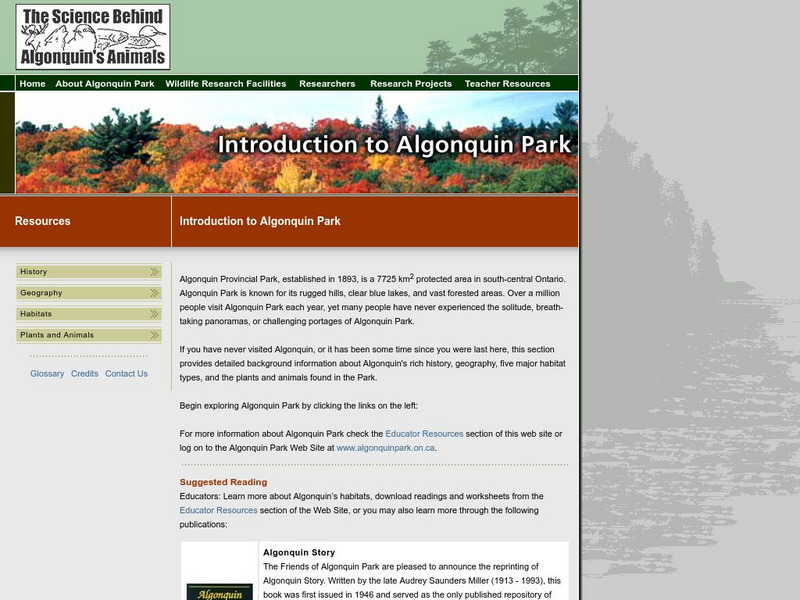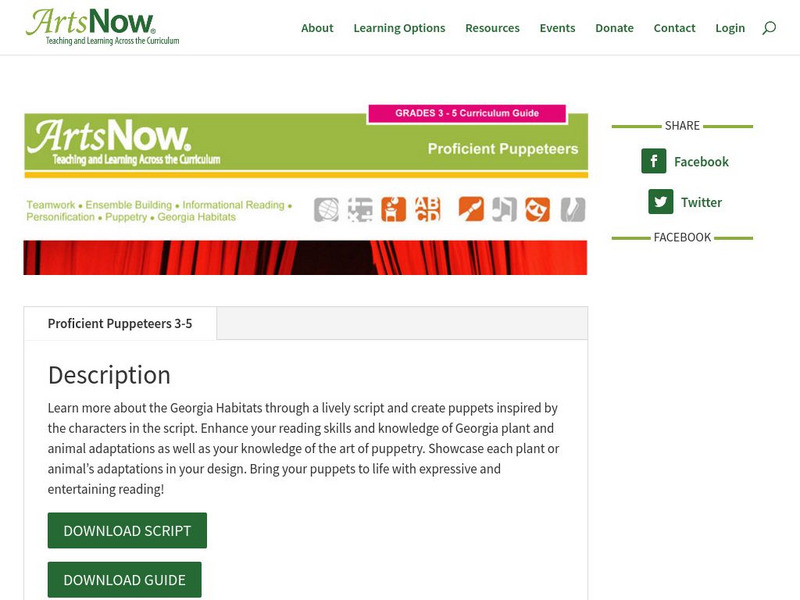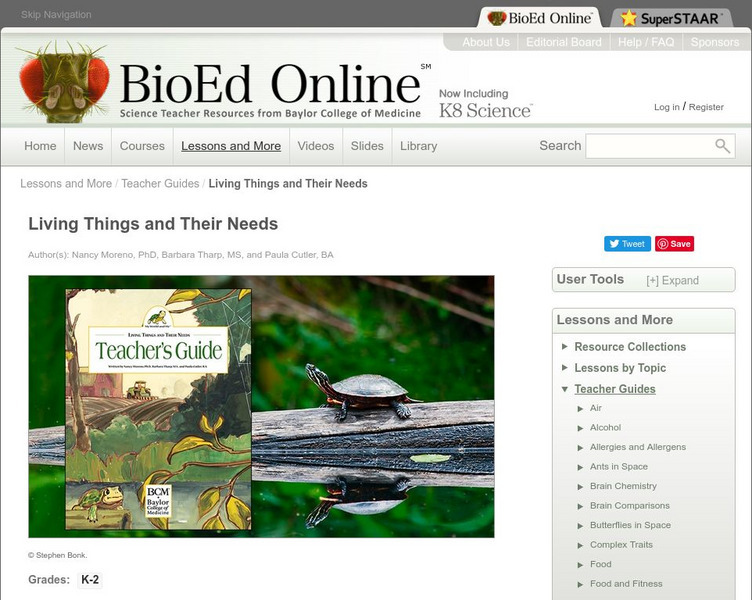Friends of Algonquin Park
The Science Behind Algonquin's Animals: Deciduous Forest
Learn about this hardwood forest, its wildlife, and plant species. View a panorama movie of a typical Hardwood Forest in the summer.
Friends of Algonquin Park
The Science Behind Algonquin's Animals: Coniferous Forest
Learn about the Coniferous Forest and its wildlife and plant species. View a panorama of a Coniferous Forest in Algonquin Provincial Park.
Utah Education Network
Uen: Utah's Plants and Animals Do You Know Where I Live?
Can you figure out what types of biomes different organisms belong in? You'll be presented with a variety of organisms and asked which of three biomes they belong in.
Songs for Teaching
Songs for Teaching: Biomes
Use this site to see how many of the animals and plants that your students can remember from each biome after listening to this song.
TeachEngineering
Teach Engineering: Biodomes
Students explore the biosphere's environments and ecosystems, learning along the way about the plants, animals, resources and natural cycles of our planet. Over the course of lessons 2-6, students use their growing understanding of...
Buck Institute
Buck Institute for Education: Pblu: Schoolyard Habitat Project
An example of a project-based learning opportunity that engages students in learning what a healthy habitat is by working within the school's campus to increase opportunity for animals to find food and shelter, maintaining plants, and...
University of Illinois
University of Illinois Extension: Natural Resources, Environment, and Ecosystems
A collection of lesson plans for specific age levels to help students gain a better understanding of animals, plants, and people, and how they affect each other in ecosystems. Many of the activities provide discussion questions and...
TeachEngineering
Teach Engineering: Got Energy? Spinning a Food Web
Students learn about energy flow in food webs, including the roles of the sun, producers, consumers and decomposers in the energy cycle. They model a food web and create diagrams of food webs using their own drawings and/or images from...
Utah Education Network
Uen: Trb 4:5 Investigation 1 Wetlands, Forests & Deserts
Learn about surface terrain and how plants and animals are affected by the temperatures and precipitation.
The Wild Classroom
The Wild Classroom: Biomes of the World: Tropical Rainforest Biome
Learn all about the Tropical Rainforest biome. Learn where rainforests are found, what defines a rainforest, layers in the rainforest, and plants and animals of the rainforest. See 2 videos about the rainforest.
ArtsNow
Arts Now Learning: Proficient Puppeteers
In this lesson plan, learners create puppets for the characters in a Reader's Theater script called 'Georgia State Animals & Plants: Habitats and Adaptations.' The puppets showcase the adaptations for each plant or animal. Students...
BioEd Online
Bio Ed Online: Living Things and Their Needs Teacher's Guide
This is a free downloadable teacher's guide (PDF) to teach young children (grades K-2) about living things and their needs.
Environmental Education for Kids
Eek!: Alien Invaders
The aliens have landed in Wisconsin! You may see them and not even know they are aliens. These invaders are actually exotic plants and animals that have been introduced to our state from other countries or habitats on purpose or by...
McGill University
Mc Gill University: Canadian Biodiversity: Ecozones: Boreal Plains
The Boreal Plains are located in the center of Alberta and extend into Saskatchewan and Manitoba. This is a brief, concise description of the location, climate, geology and flora and fauna. It includes a collection of images of the...
PBS
Pbs: Biogeography Polar Bears and Penguins
From the Evidence for Evolution Library at PBS, this is a short article about biogeography. The distribution of animals is one source of evidence for Darwin's descent with modification.
Alabama Learning Exchange
Alex: Our Trip Around the Biomes
During this lesson, students travel to the biomes by way of the Internet. They learn the characteristics of biomes, including animals, plants, temperatures, etc. Students then use this information to create a slideshow presentation to...
Science Struck
Science Struck: Arabian Desert Facts
Presents interesting information about the Arabian Desert, including its physical geography, climate, plants and animals, their adaptations to the environment, natural resources, and threats to its habitats.
Other
Ttu: Alpine Tundra
Information on the land uses, plants, wildlife, habitats and soil. There are literature citings at the bottom of the page.
McGill University
Mc Gill University: Canadian Biodiversity: Ecozones: Prairies
This Prairies ecozone covers southern Alberta, Saskatchewan, and Manitoba. This brief, concise description includes a collection of images of the animals and birds native to the location. Many of the images include descriptions.
CK-12 Foundation
Ck 12: Life Science: Terrestrial Biomes
[Free Registration/Login may be required to access all resource tools.] A terrestrial biome is an area of land with a similar climate that includes similar communities of plants and animals. Different terrestrial biomes are usually...
Houghton Mifflin Harcourt
Harcourt: School Publishers: Exploring Ecosystems
Compare and contrast three very different ecosystems - the Sonoran Desert in Arizona, the Florida Everglades, and the Arctic Coastal Plain in Alaska. Learn what makes each of them unique, and about the adaptations plants and animals had...
Science Education Resource Center at Carleton College
Serc: Discovering Nature in Our Neighborhood: Investigating Natural Communities
Students examine the natural surroundings around the school and identify micro-communities of plants, insects, and other animals through walks and nature journaling.
Missouri Botanical Garden
Missouri Botanical Garden: What's It Like Where You Live?
Learn about each biome with this site. Site will give you information about the plants, animals, and the climate found at each biome.
Other
Rainforest Alliance: Species Profiles
This resource has rain-forest species profiles for amphibians, birds, mammals, insects, and plants. Each profile explains the organism's anatomy, habitat, diet, and threats.






















